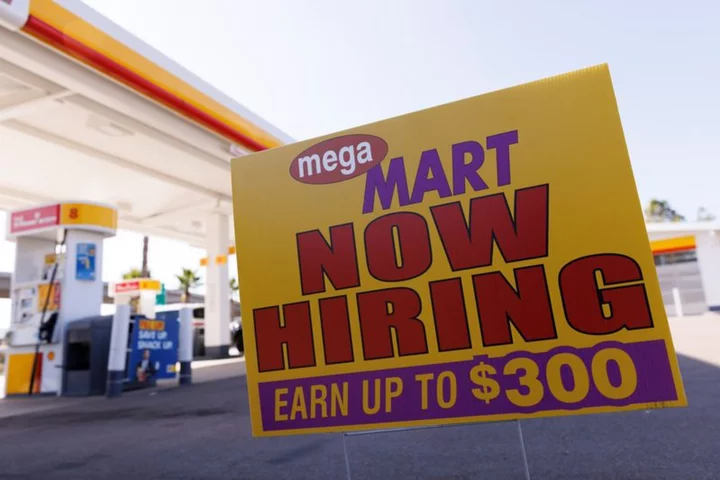By Lucia Mutikani
WASHINGTON U.S. growth likely slowed in June after surging in the prior two months, but labor market conditions remain tight, with the unemployment rate expected to have retreated from a seven-month high and fairly strong wage gains persisting.
The Labor Department's closely watched employment report on Friday will be among factors leading the Federal Reserve to resume raising interest rates this month as signaled by the U.S. central bank and Chair Jerome Powell, after pausing in June.
The labor market has remained unbowed despite the Fed delivering 500 basis points worth of rate hikes since March 2022 when it embarked on its fastest monetary policy tightening campaign in more than 40 years. It is for now helping the economy to defy analysts' predictions of a recession.
While the higher paying industries such as technology and finance are purging workers, sectors like leisure and hospitality as well local government and education are still catching up after losing employees and experiencing accelerated retirements during the COVID-19 pandemic.
"Monetary policy has been working in slowing employment growth since its peak about a year ago," said Sung Won Sohn, finance and economics professor at Loyola Marymount University in Los Angeles. "However, that doesn't mean that we will see a recession, the probability of a recession has diminished."
The survey of establishments is likely to show nonfarm payrolls increased by 225,000 jobs last month after rising 339,000 in May and 294,000 in April, according to a Reuters survey of economists.
The economy needs to create 70,000-100,000 jobs per month to keep up with growth in the working-age population. Payrolls could surprise on the upside as the survey was conducted before a slew of data on Thursday showing a surge in private payrolls.
Government data also showed there were 1.6 job openings for every unemployed person in May, while the Institute for Supply Management's measure of services employment rebounded strongly, with businesses reporting they were unable to find qualified candidates for some open positions and "finally able to fill some positions that have been open for some time."
A Conference Board survey last month showed consumers' perceptions of the labor market more upbeat in June relative to May. But first-time applications for unemployment benefits jumped to a 20-month high during the week that the government surveyed businesses for the nonfarm payrolls count.
The unemployment rate is forecast dropping to 3.6% from 3.7% in May, which would leave it just shy of a 53-year low of 3.4% touched in April.
WORKER HOARDING
Employment growth is also being driven by companies hoarding workers, a legacy of the dire labor shortages experienced as the economy rebounded from the COVID downturn in 2021 and early 2022.
"The pandemic has really caused businesses to hold on to labor more because they know how difficult it is to fill open positions," said Ryan Sweet, chief economist at Oxford Economics in West Chester Pennsylvania. "They are going to opt to cut hours worked, that is something we need to pay very close attention to, rather than the net gain in nonfarm payrolls."
The average workweek was forecast unchanged at 34.3 hours. It has declined from 34.6 hours in January.
But some economists argued that worker hoarding was masking weakness in the economy, pointing to worker productivity, which slumped in the first quarter. They also noted that while gross domestic product, the traditional measure of economic growth, was solid in the January-March quarter, an alternative gauge, gross domestic income, has contracted for two straight quarters.
While businesses were content for now to continue hoarding workers, that could change once slowing consumer spending starts to erode profits, the economists said, predicting major layoffs.
"When that becomes apparent businesses will say we can't afford to just keep paying people not to produce and that's what the productivity numbers show," said Milton Ezrati, chief economist at Vested in New York. "It's going to shock people when business realize they have excess employment."
Average hourly earnings were expected to have increased 0.3% in June, matching May's rise. That would lower the annual increase in wages to 4.2% from 4.3% in May, still way above levels consistent with the Fed's 2% inflation target.
The slowdown in wage growth is being driven by the loss of high-paying technology and finance jobs among others. While the moderation in wage inflation would be welcomed by policymakers, it also portends to slower consumer spending, the main anchor of the economy, making a recession likely for some economists.
"If we keep adding jobs at the lower end of the wage spectrum, but losing jobs at a higher end, that will lead to a significant slowdown in terms of growth in disposable personal income," said Yelena Shulyatyeva, a senior economist at BNP Paribus in New York. "That is not good for everybody, it could eventually lead to layoffs in all other industries, even in leisure and hospitality."
(Reporting By Lucia Mutikani; Editing by Daniel Wallis)









